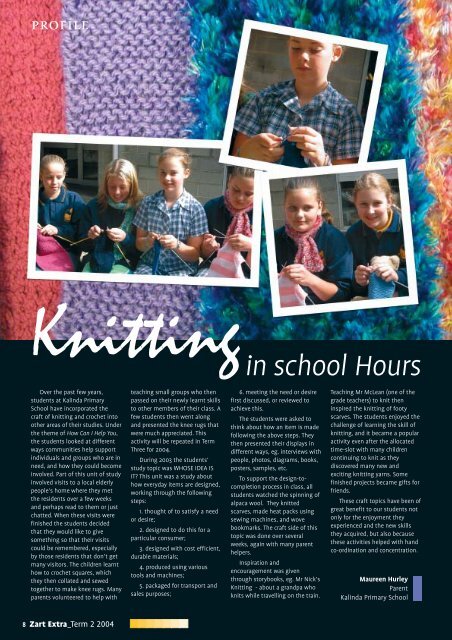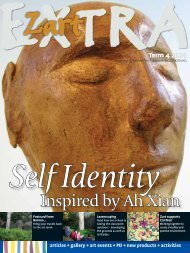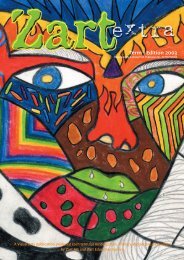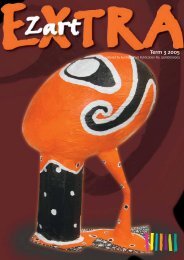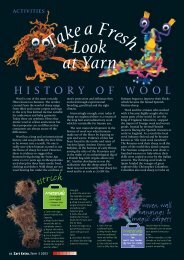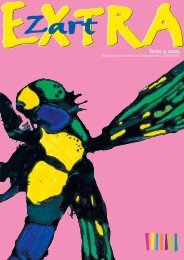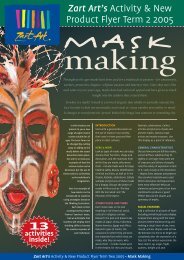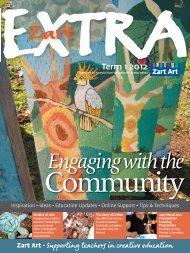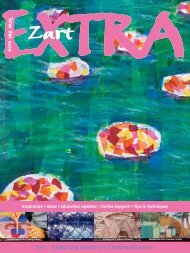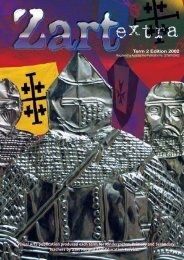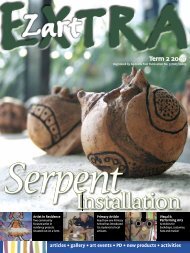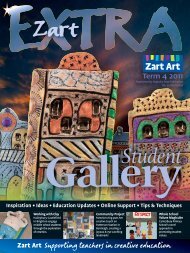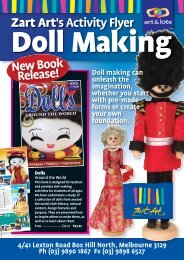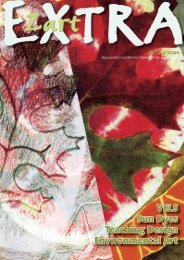Term 2 2004 - Zart Art
Term 2 2004 - Zart Art
Term 2 2004 - Zart Art
- No tags were found...
Create successful ePaper yourself
Turn your PDF publications into a flip-book with our unique Google optimized e-Paper software.
profile<br />
Knitting<br />
in school Hours<br />
Over the past few years,<br />
students at Kalinda Primary<br />
School have incorporated the<br />
craft of knitting and crochet into<br />
other areas of their studies. Under<br />
the theme of How Can I Help You,<br />
the students looked at different<br />
ways communities help support<br />
individuals and groups who are in<br />
need, and how they could become<br />
involved. Part of this unit of study<br />
involved visits to a local elderly<br />
people’s home where they met<br />
the residents over a few weeks<br />
and perhaps read to them or just<br />
chatted. When these visits were<br />
finished the students decided<br />
that they would like to give<br />
something so that their visits<br />
could be remembered, especially<br />
by those residents that don’t get<br />
many visitors. The children learnt<br />
how to crochet squares, which<br />
they then collated and sewed<br />
together to make knee rugs. Many<br />
parents volunteered to help with<br />
teaching small groups who then<br />
passed on their newly learnt skills<br />
to other members of their class. A<br />
few students then went along<br />
and presented the knee rugs that<br />
were much appreciated. This<br />
activity will be repeated in <strong>Term</strong><br />
Three for <strong>2004</strong>.<br />
During 2003 the students’<br />
study topic was WHOSE IDEA IS<br />
IT This unit was a study about<br />
how everyday items are designed,<br />
working through the following<br />
steps:<br />
1. thought of to satisfy a need<br />
or desire;<br />
2. designed to do this for a<br />
particular consumer;<br />
3. designed with cost efficient,<br />
durable materials;<br />
4. produced using various<br />
tools and machines;<br />
5. packaged for transport and<br />
sales purposes;<br />
6. meeting the need or desire<br />
first discussed, or reviewed to<br />
achieve this.<br />
The students were asked to<br />
think about how an item is made<br />
following the above steps. They<br />
then presented their displays in<br />
different ways, eg. interviews with<br />
people, photos, diagrams, books,<br />
posters, samples, etc.<br />
To support the design-tocompletion<br />
process in class, all<br />
students watched the spinning of<br />
alpaca wool. They knitted<br />
scarves, made heat packs using<br />
sewing machines, and wove<br />
bookmarks. The craft side of this<br />
topic was done over several<br />
weeks, again with many parent<br />
helpers.<br />
Inspiration and<br />
encouragement was given<br />
through storybooks, eg. Mr Nick’s<br />
Knitting - about a grandpa who<br />
knits while travelling on the train.<br />
Teaching Mr McLean (one of the<br />
grade teachers) to knit then<br />
inspired the knitting of footy<br />
scarves. The students enjoyed the<br />
challenge of learning the skill of<br />
knitting, and it became a popular<br />
activity even after the allocated<br />
time-slot with many children<br />
continuing to knit as they<br />
discovered many new and<br />
exciting knitting yarns. Some<br />
finished projects became gifts for<br />
friends.<br />
These craft topics have been of<br />
great benefit to our students not<br />
only for the enjoyment they<br />
experienced and the new skills<br />
they acquired, but also because<br />
these activities helped with hand<br />
co-ordination and concentration.<br />
Maureen Hurley<br />
Parent<br />
Kalinda Primary School<br />
8 <strong>Zart</strong> Extra_<strong>Term</strong> 2 <strong>2004</strong>


